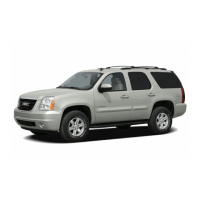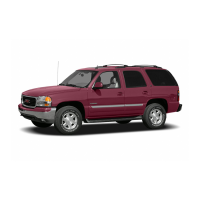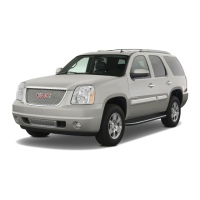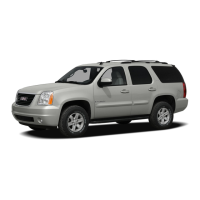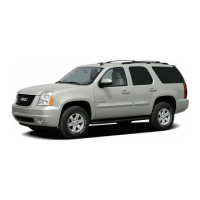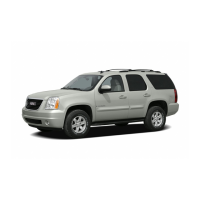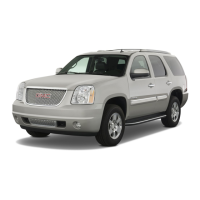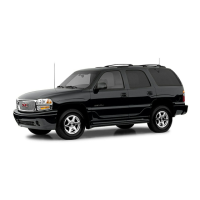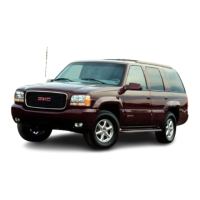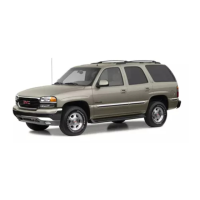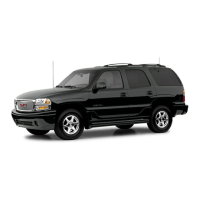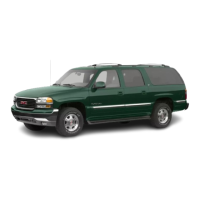
Do you have a question about the GMC YUKON XL 2003 and is the answer not in the manual?
| Brand | GMC |
|---|---|
| Model | YUKON XL 2003 |
| Category | Automobile |
| Language | English |
These mean there is something that could hurt you or other people.
A notice will tell you about something that can damage your vehicle...
Covers manual, power, heated, and reclining seat adjustments and head restraints.
Details rear seat operation, folding, and specific bench seat types.
Explains proper safety belt use, pregnancy considerations, and comfort guides.
Covers older children, infants, restraint systems, LATCH, and placement.
Discusses air bag inflation, location, and restraint.
Covers entering/exiting third-row seats and the easy entry seat feature.
Details the folding mechanism of the 60/40 split rear seat for cargo space.
Details how to recline bucket seatbacks using the lever at the seat base.
Instructions for folding rear bucket seats, including head restraint removal.
Explains proper safety belt usage and precautions for all occupants.
Explains the physics and legal reasons behind safety belt effectiveness.
Addresses common questions about safety belt use, especially in relation to airbags.
Provides guidance for adults on proper safety belt positioning and use.
Details how to wear the driver's lap-shoulder belt correctly and securely.
Offers guidance on proper safety belt usage for pregnant women.
Explains the proper use of the right front passenger's safety belt, including airbag interaction.
Describes lap-shoulder belt use for the center seating position.
Details how to adjust and wear a lap belt correctly for the center seating position.
Emphasizes the importance of buckling up rear seat passengers to prevent injury.
Explains lap-shoulder belt use for rear seat positions next to windows.
Instructions on installing and using comfort guides for rear seat belts.
Explains how to obtain and use a safety belt extender if the standard belt is too short.
Guidance on proper safety belt usage for older children who have outgrown booster seats.
Highlights the necessity of child restraints for infants and young children due to safety laws.
Recommends rear seat placement for child restraints and outlines precautions for front seat use.
Explains the function and anchoring requirements of top tether straps for child restraints.
Details anchor point locations for top straps in different vehicle seating positions.
Explains the LATCH system and how to locate its anchors in the vehicle.
Step-by-step guide for installing a child restraint using the LATCH system.
Instructions for securing a child restraint using a lap-shoulder belt in a rear outside seat.
Guidance on securing child restraints in the second and third row center seats.
Caution against using child restraints in the center front seat due to improper function.
Details precautions for installing child restraints in the right front seat, especially with airbags.
Identifies the locations of frontal and side impact air bags within the vehicle.
Explains the conditions and criteria for frontal air bag deployment.
Details side impact air bag operation, deployment conditions, and limitations.
Explains how air bag systems determine inflation based on crash severity and gas release.
Describes how sensors determine seat position to enable/disable air bag deployment.
Explains how sensing systems trigger air bag inflation based on crash severity and gas release.
Details how air bags distribute impact force and supplement safety belts for occupant protection.
Describes post-inflation effects like smoke, dust, and warm components.
Provides guidance on servicing vehicles with air bag systems and cautions about potential inflation.
Discusses how aftermarket additions can affect air bag system performance.
Instructions for checking safety belts, buckles, and other restraint system parts for proper function.
Guidance on inspecting and replacing restraint systems after a collision for safety.
Safety caution regarding leaving keys in the vehicle with children and information on key replacement.
Details manual and power door locking, lockout protection, and liftgate operation.
Covers manual, power, and express-down window operation and safety cautions.
Explains content theft-deterrent alarm system operation and testing procedures.
Covers new vehicle break-in, ignition positions, and starting the engine.
Describes manual, automatic dimming, and power mirror adjustments, including compass/temp displays.
Explains shift lever positions, including PARK, REVERSE, NEUTRAL, and DRIVE modes.
Details how to use the four-wheel drive system for enhanced traction and operation.
Explains the automatic locking and unlocking of the front axle with transfer case shifts.
Describes the different driving settings (2HI, 4HI, AUTO 4WD, 4LO) for the transfer case.
Lists various OnStar services, including safety, security, and convenience features.
Describes the hands-free wireless phone feature for making nationwide calls.
Explains how to access news, traffic, and other information via the Virtual Advisor.
Details how to use steering wheel controls to interact with the OnStar system.
Step-by-step guide for programming up to three garage door openers or other devices.
Instructions on how to open the glove box by lifting the latch and pulling the door.
Identifies locations of cupholders in the front and rear console areas.
Details the center armrest storage compartment in the front bench seat and its features.
Explains the console compartment between bucket seats and how to open it.
Provides guidance on loading items onto the roof luggage carrier and securing cargo.
Details storage compartment in rear cargo area and how to open it.
Explains the use and installation of a convenience net for securing small loads.
Describes the cargo cover and tie-down points for securing items in the rear cargo area.
Instructions on using cargo tie-downs to secure items in the rear cargo area.
Details how to program and recall driver's seat, mirror, and radio presets using memory buttons.
Explains programming and recalling driver's seat exit positions via button or key removal.
Details how to select display units for information (English or Metric).
Instructions for selecting the display language for vehicle information.
Illustrates the instrument panel and identifies its various components and controls.
Explains the function of hazard warning flashers to alert others and signal a problem.
Suggests using reflective triangles to warn other drivers of a disabled vehicle.
Instructions on how to sound the horn by pressing the center pad on the steering wheel.
Describes how to adjust the steering wheel's tilt for better entry/exit and driving position.
Details the operation of turn signals, headlamp controls, wipers, and cruise control.
Covers operation of exterior lamps including AUTO, parking lamps, and headlamps.
Explains instrument panel brightness, exit lighting, entry lighting, and reading lamps.
Covers using power outlets for accessories like phones and CB radios, with cautions.
Details the location and use of front ashtrays and the cigarette lighter, with cautions.
Covers fan speed, temperature selection, and air delivery modes for climate control.
Overview of the climate control system, including fan, temperature, and mode adjustments.
Explains control of heating, cooling, and ventilation, including dual zone operation and memory settings.
Details the front and rear controls for the rear air conditioning system, including fan speed.
Covers front controls for rear AC/heating: fan, temperature, and airflow location.
Explains front controls for rear AC/heating, auto settings, and off position.
Describes various warning lights and gages that signal vehicle status or potential problems.
Illustrates the instrument cluster and explains its function in displaying vehicle status.
Explains how the speedometer and odometer display vehicle speed and distance driven.
Details how to toggle and reset the trip odometer for tracking distance traveled.
Explains how to display the engine hour meter, showing total engine run time.
Describes the tachometer's function in displaying engine speed in revolutions per minute (rpm).
Covers the safety belt reminder light and chime that alerts occupants to buckle up.
Explains the air bag readiness light, its function in checking the system, and when to seek service.
Describes the passenger air bag status indicator on the mirror and its meaning (ON/OFF).
Explains the battery warning light and potential issues with the charging system.
Describes the voltmeter gage for checking battery charge and charging system condition.
Covers the brake system warning light, its activation with the parking brake, and potential brake problems.
Explains the ABS warning light, its self-check procedure, and when it indicates a problem.
Details the traction off light, its causes, and system operation when it's on.
Explains the engine coolant temperature gage and its normal operating range and indicators.
Describes the transmission temperature gage, its normal operating range, and potential issues.
Explains the Check Engine light, its causes, and the importance of diagnosis and service.
Explains the oil pressure gage, normal operating range, and potential causes of low pressure.
Indicates when the cruise control system is engaged, referencing the Turn Signal/Multifunction Lever section.
Explains the four-wheel drive indicator light that illuminates when the system is engaged.
Indicates when the tow/haul mode has been activated for towing a trailer.
Explains how the fuel gage indicates fuel level and situations that may affect readings.
Describes the low fuel warning light and the action required to turn it off.
Overview of the DIC display, its functions, and how it shows vehicle status and messages.
Explains how the DIC operates, displays information, and acknowledges warning messages.
Details how warning messages are displayed on the DIC that require driver action.
Explains how to scroll through trip odometer, hourmeter, and annual log data using the trip button.
Details the personal trip odometer, fuel economy, average speed, and annual mileage ratio.
Covers business trip odometer, fuel usage, average economy, and speed data.
Explains how to display the total distance driven since the last season odometer reset.
Describes how the hourmeter shows the total number of hours the engine has run.
Explains how to view and reset the annual log, which shows accumulated mileage.
Details using the DIC as a stopwatch to measure elapsed time.
Explains how to scroll through fuel range, economy, and oil life information using the button.
Describes how to display remaining driving distance based on fuel economy and remaining fuel.
Details how to display and reset average fuel economy (miles per gallon).
Explains how to display instant fuel economy (miles per gallon) at the current moment.
Covers the GM Oil Life System for estimating oil life and indicating when to change oil.
Explains how to program features to preferred settings for up to two people via the DIC.
Details how to select personalization for alarm warning type (BOTH, OFF, HORN, LAMPS).
Instructions for personalizing automatic door locking based on park status, manual, or speed.
Details personalization options for automatic door unlocking when shifting into PARK or removing the key.
Explains how to recall saved seat positions via memory buttons, key-in-ignition, or remote unlock.
Covers personalization for perimeter lights, including delay settings for headlamps and backup lamps.
Details personalization options for feedback received when locking the vehicle with the remote transmitter.
Explains personalization for feedback when unlocking the vehicle with the remote transmitter.
Allows personalization of how long headlamps stay on after turning off the vehicle, with delay options.
Describes the feature that tilts mirrors down when shifting to REVERSE for parking assistance.
Indicates the stability system is active to help maintain directional control, especially in adverse conditions.
Message indicating Stabilitrak is off or disabled; advises normal driving with reduced stability features.
Overview of the audio system, including Base and Bose amplified speakers, and Radio Data System (RDS) features.
Instructions on tuning radio stations using the BAND button and TUNE knob, including seek and scan functions.
Guide to setting up to 30 favorite radio stations on AM, FM, XM, or DAB bands using numbered pushbuttons.
Explains how to adjust bass, midrange, and treble levels, and reset them to the middle position.
Details choosing preset equalization settings for different music genres or custom tuning.
Instructions on adjusting speaker balance (left/right) and fade (front/rear) using the AUDIO knob.
Guide to finding stations by Program Type (PTY) using RDS, XMTM, and DAB features.
Instructions for inserting, playing, and controlling CDs, including error messages.
Lists common CD error messages and their potential causes and solutions.
Overview of the audio system with cassette and CD player, including Radio Data System (RDS) features.
Overview of the six-disc CD system and Radio Data System (RDS) features.
Explains how to listen to DVD audio through the vehicle's speakers or headphones.
Details the location and control of the overhead DVD player, including power and compatibility.
Overview of the RSE system, including DVD player, screen, headphones, and remote control.
Explains the parental control function to freeze video and mute audio, and how to restore normal operation.
Details how to use the overhead video screen, adjust its position, and cautions about touching it.
Provides instructions on using the remote control, including aiming, battery replacement, and signal interference.
Lists potential DVD error messages displayed on the video screen and their meanings.
Emphasizes defensive driving techniques like maintaining following distance and avoiding distractions.
Highlights the dangers of alcohol-impaired driving and its effects on judgment and coordination.
Explains braking action involving perception and reaction time, and stopping distances.
Details the Anti-lock Brake System (ABS) and Dynamic Rear Proportioning (DRP) system.
Describes the Traction Assist System for limiting wheel spin and its operation.
Explains how traction control limits wheel spin by reducing engine power and applying brakes.
Details the locking rear axle feature for improved traction in slippery conditions.
Describes the Stabilitrak system combining ABS, traction, and stability control for directional stability.
Covers power steering and provides tips for driving on curves and in emergencies.
Explains the effect of losing power steering assist on vehicle steering effort.
Provides tips for driving on curves, emphasizing speed control and avoiding sudden maneuvers.
Offers advice on evasive steering maneuvers for emergencies and practicing defensive driving.
Explains the QUADRASTEER system's control module, status monitoring, and driving modes.
Describes how front and rear wheels steer in opposite directions at slower speeds for tighter turns.
Explains how wheels steer in the same direction at higher speeds for improved stability.
Details the tow mode for enhanced stability when towing trailers, improving trailer path following.
Provides guidance on selecting appropriate car washes for vehicles with QUADRASTEER to avoid damage.
Provides advice on recovering a vehicle that has driven off the road edge onto the shoulder.
Offers tips for safe passing on two-lane highways, emphasizing situational awareness and caution.
Explains how drivers can lose control in skids and the three types of skids related to vehicle controls.
Details the three types of skids (braking, steering, acceleration) and how to handle them.
Provides an off-road guide for four-wheel-drive vehicles, covering terrain hazards and new skills.
Urges off-roaders to follow basic rules for protecting the environment, including trail use and waste disposal.
Emphasizes planning trips to remote areas, knowing terrain, and traveling with others.
Suggests practicing off-road driving skills in safe areas and tuning senses to vehicle feedback.
Provides advice on assessing terrain conditions and surface obstacles for safe off-road driving.
Offers guidance on approaching and driving on off-road hills, considering steepness and surface conditions.
Provides steps for safely driving uphill, including gear selection and approaching the crest.
Considerations for driving downhill, including steepness, surface, and obstacles.
Advice on driving across inclines, including risks of rolling over and handling sideways slides.
Provides procedures and cautions for vehicles stalling on an incline, both uphill and downhill.
Offers tips for driving in various slippery conditions, including traction and speed adjustments.
Discusses driving challenges in rain and on wet roads, including traction, visibility, and wiper maintenance.
Explains the dangers of hydroplaning and factors contributing to it, advising slower speeds in rain.
Cautions against driving through deep water due to potential engine damage and risks.
Warns about the dangers of flowing water, including vehicle loss and drowning risks.
Provides tips for rainy weather, including using low-beam headlamps and extra following distance.
Offers safety tips for city driving, focusing on traffic, signals, and route planning.
Provides advice for freeway driving, emphasizing keeping up with traffic and proper lane usage.
Offers guidance on preparing for long trips, including vehicle checks and driver readiness.
Discusses highway hypnosis and provides tips for staying alert and avoiding fatigue.
Highlights differences in driving on hills and mountains compared to flat terrain.
Provides steps for safely driving uphill, including gear selection and approaching the crest.
Considerations for driving downhill, including steepness, surface, and obstacles.
Advice on driving across inclines, including risks of rolling over and handling sideways slides.
Provides procedures and cautions for vehicles stalling on an incline, both uphill and downhill.
Offers tips for driving in various slippery conditions, including traction and speed adjustments.
Provides safety tips for surviving a blizzard, including vehicle use and summoning help.
General advice and considerations for towing a vehicle, including capacity and equipment.
Guidance on towing a disabled vehicle and recreational vehicle towing methods.
Explains dinghy towing and dolly towing methods for recreational vehicle towing.
Details the procedure for dinghy towing, including turning the ignition to LOCK.
Advises against towing two-wheel-drive vehicles with rear wheels on the ground; recommends platform trailers.
Provides the procedure for towing four-wheel-drive vehicles, including transfer case and ignition settings.
Explains dolly towing procedures for two-wheel-drive and cautions against it for Stabilitrak-equipped vehicles.
Provides guidance on loading the vehicle, emphasizing weight distribution and avoiding overloading.
Describes the self-adjusting rear suspension and automatic level control systems.
Explains how the self-adjusting rear suspension works and levels the vehicle.
Details the automatic level control rear suspension and its interaction with the Autoride system.
Describes the Autoride feature for superior ride and handling, adjusting damping levels.
Advises subtracting hitch loads from CWR and weighing the vehicle with trailer attached.
Provides essential steps, dealer advice, and cautions for safely towing a trailer.
Explains the tow/haul mode feature for assisting with heavy loads and trailers.
Provides charts to determine vehicle towing capacity based on model, options, and axle ratio.
Explains the importance of measuring tongue load and its effect on vehicle weight.
Advises checking tire inflation and avoiding exceeding vehicle weight limits, including trailer tongue.
Highlights the importance of correct hitch equipment for safety, especially on rough roads or turns.
Instructions on attaching safety chains to the trailer tongue and bumper for safety.
Details requirements for trailer brakes weighing over 2,000 lbs and their integration with the vehicle's system.
Encourages using dealer services for genuine GM parts and trained personnel.
Provides guidance on performing DIY service, emphasizing the use of proper manuals and tools.
Discusses how exterior additions can affect airflow, noise, and washer performance.
Covers gasoline octane requirements, specifications, and fuel types like E-85.
Explains octane rating requirements and potential engine damage from using lower octane fuel.
Recommends meeting specific gasoline specifications for optimal vehicle performance and engine protection.
Discusses operating on fuels meeting California emissions standards and potential effects of non-compliance.
Explains that gasolines now contain additives for cleaner air and GM recommends using them.
Details E-85 fuel compatibility, formulation requirements, and where to find it.
Advises checking fuel availability and avoiding improper fuels when driving outside the US or Canada.
Provides cautions about fuel vapor flammability and safe refueling procedures.
Cautions against filling portable containers in vehicles due to static electricity risks.
Highlights fire hazards from hot engine parts and liquids; advises caution when working under the hood.
Instructions on how to open the vehicle's hood using the interior handle and secondary release.
Diagrams identifying key components in the engine compartments for V8 engines.
Explains how to check the engine oil level and the importance of regular checks.
Provides instructions on checking engine oil level, emphasizing warm engine and level ground.
Details when to add oil based on dipstick level and cautions against overfilling.
Guides on identifying recommended engine oils by API starburst symbol and viscosity grade.
Explains the GM Oil Life System for indicating oil change needs based on engine conditions.
Provides instructions on resetting the 'CHANGE ENGINE OIL' message after servicing.
Describes the air cleaner/filter assembly and its indicator for service needs.
Step-by-step guide for replacing the engine air cleaner/filter, with safety cautions.
Covers when to check and change automatic transmission fluid and filter based on driving conditions.
Provides instructions for checking transmission fluid level, emphasizing accuracy and cautions.
Explains the DEX-COOL@ coolant system and how to add coolant when the level is low.
Details the coolant surge tank pressure cap and its importance for preventing coolant loss.
Discusses engine overheating, related messages, and the overheat protection mode.
Provides cautions and procedures for dealing with steam from an overheated engine.
Offers troubleshooting steps for overheat warnings without steam, advising slower driving or service.
Shows the location of cooling system components and cautions about working with hot coolant.
Explains the cause of engine fan noise and how it relates to the clutch engaging for cooling.
Details when to check and how to check power steering fluid level.
Provides guidance on what type of windshield washer fluid to use and cautions about freezing.
Instructions on how to open the cap and add washer fluid, with cautions about concentrated fluid and freezing.
Discusses brake fluid type, reasons for fluid level decrease, and the importance of proper system maintenance.
Explains the type of brake fluid used and the implications of leaks or improper topping off.
Describes how to check brake fluid level without removing the cap and cautions about fluid spills.
Guidance on using only DOT-3 brake fluid from a sealed container and cautions about wrong fluid.
Explains built-in wear indicators on brake pads and cautions about continuing to drive with worn pads.
Advises seeing a dealer if the brake pedal does not return to normal or shows rapid travel increase.
Notes that disc brakes adjust automatically for wear with each stop.
Emphasizes using top-quality GM brake parts for proper vehicle braking performance.
Information on the maintenance-free ACDelco battery and cautions about battery acid and gas.
Provides guidance on preparing the vehicle for storage, including battery cable removal and cautions.
Details the procedure for safely jump-starting a vehicle with a dead battery, including cautions.
Step-by-step instructions for safely disconnecting jumper cables from both vehicles.
Explains lubricant checks for all-wheel drive vehicles and additional systems requiring lubrication.
Covers when to check lubricant and how to check the transfer case lubricant level.
Details when to check lubricant and how to check the front axle lubricant level.
Covers bulb replacement procedures not listed in the section, referring to replacement bulbs page.
Instructions for replacing headlamp bulbs, including cautions about halogen bulbs.
Details bulb replacement for front turn signals, sidemarkers, and daytime running lamps.
Instructions for accessing and replacing side identification marker lamps.
Details the procedure for removing screws and lifting the lens to replace roof marker lamps.
Instructions for removing the lamp assembly and replacing bulbs in the taillamps.
Provides a table of exterior lamp bulb numbers and advises contacting the dealer for unlisted bulbs.
Offers guidance on inspecting wiper blades for wear and replacing them.
Provides information on tire quality grading, treadwear, traction, and temperature ratings.
Guides on selecting new tires based on Certification/Tire label and TPC Spec numbers.
Explains the Uniform Tire Quality Grading system for treadwear, traction, and temperature.
Highlights the importance of factory alignment/balancing for tire life and performance.
Provides guidance on replacing wheels, including cautions about using correct nuts and potential damage.
Cautions against using tire chains on specific tire sizes due to clearance issues and potential damage.
Offers tips on handling a front or rear tire blowout and safely stopping the vehicle.
Step-by-step instructions for changing a flat tire, including safety precautions and vehicle positioning.
Details the location and removal of tools and the spare tire for Tahoe/Yukon and Suburban/Yukon XL models.
Provides instructions for storing the flat tire and tools, with cautions about loose equipment and wheel damage.
Offers general advice on cleaning products, safety precautions, and what not to use on the vehicle.
Guides on cleaning interior surfaces using vacuum cleaners and damp cloths.
Provides cleaning tips for fabric and carpet, including stain removal and using approved products.
Step-by-step instructions for cleaning fabric stains using a sponge and cleaner.
Offers specific cleaning solutions for common fabric stains like catsup, coffee, and vomit.
Instructions for cleaning vinyl surfaces with warm water and a soft cloth, avoiding heat drying.
Details cleaning leather with mild soap and water, and cautions against harsh cleaners.
Advises cleaning top surfaces of the instrument panel with mild soap and water, avoiding reflections.
Recommends using mild soap and water solutions for cleaning interior plastic components.
Provides guidance on cleaning glass surfaces, including cautions against abrasive cleaners and decals.
Covers waxing and polishing for basecoat/clearcoat finishes, and avoiding machine compounding.
Advice on cleaning bright metal parts, using chrome polish, and caring for aluminum trim.
Covers cleaning windshields, backglass, and wiper blades for optimal visibility.
Instructions for cleaning aluminum and chrome-plated wheels, with cautions about cleaners.
Provides information on tire quality grading, treadwear, traction, and temperature ratings.
Emphasizes applying anti-corrosion material for sheet metal repairs to restore protection.
Advises prompt repair of stone chips and scratches to prevent corrosion.
Explains the importance of removing underbody chemicals to prevent corrosion.
Discusses chemical fallout damage to paint and GM's repair policy for new vehicles.
Lists GM-approved cleaning products and their usage for various vehicle surfaces.
Explains the Vehicle Identification Number (VIN) and its location on the vehicle.
Highlights the importance of the label in the glove box for ordering parts.
Covers add-on electrical equipment, windshield wiper fuses, power options, and fuses/circuit breakers.
Cautions about adding electrical equipment and its potential impact on vehicle systems and warranty.
Explains fuse protection for the windshield wiper motor and steps to take if it overheats.
Describes circuit breakers protecting power windows and accessories from overload.
Explains how fuses and circuit breakers protect wiring from short circuits and fires.
Details the location of the fuse block access door and how to remove fuses.
Shows the fuse block located under the instrument panel and lists device/usage pairings.
Explains the location of the underhood fuse block and how to access and remove fuses.
Provides a schedule for maintenance services, owner checks, inspections, and recommended fluids.
Outlines maintenance requirements, intervals, and the importance of proper vehicle care.
Emphasizes how proper maintenance contributes to vehicle condition and environmental protection.
States the necessity of maintenance intervals and cautions that damage from neglect may void warranty.
Explains engine oil and chassis lubrication schedules, including engine oil life system.
Guides owners on using the maintenance schedule based on driving habits and conditions.
Details maintenance services up to 100,000 miles and their repetition intervals.
Covers engine oil changes based on the GM Oil Life System and chassis lubrication intervals.
Lists owner checks and services to be performed at specified intervals for safety and performance.
Recommends performing underhood checks at each fuel fill, including oil and coolant levels.
Instructions on checking the engine oil level and adding proper oil if necessary.
Details checking the engine coolant level and adding the proper DEX-COOL mixture.
Covers checking windshield washer fluid level and adding proper fluid if needed.
Recommends monthly checks including tire inflation pressure and spare tire.
Emphasizes checking tire inflation pressures when tires are cold and checking the spare tire.
Recommends cleaning the cassette tape player every 50 hours of tape play.
Covers checks and services to be performed twice a year, including restraint systems and wiper blades.
Ensures safety belts, buckles, and other restraint components are working properly.
Inspects wiper blades for wear or cracking and advises replacement if necessary.
Recommends checking spare tire inflation and secure storage at least twice a year.
Details applying silicone grease to weatherstrips for longevity and proper sealing.
Covers checking automatic transmission fluid level and inspecting for leaks.
Outlines annual inspections and services for key lock cylinders and body lubrication.
Instructions for lubricating key lock cylinders with specified lubricant.
Details lubricating various body components like hinges, latches, and locks.
Lists periodic inspections for steering, suspension, exhaust, fuel, and cooling systems.
Inspects steering and suspension for damage, wear, or lubrication issues.
Inspects the exhaust system for damage, leaks, and loose connections.
Inspects the complete fuel system for any damage or leaks.
Details inspecting hoses, pipes, and clamps, and pressure testing the cooling system.
Covers checking and lubricating front axle and transfer case, and inspecting vent hoses.
Inspects brake lines, hoses, pads, rotors, calipers, and parking brake for wear and condition.
Lists recommended fluids and lubricants by name, part number, or specification for vehicle maintenance.
Provides a template for recording maintenance services, dates, and receipts for vehicle history.
Provides information on customer assistance procedures, online resources, and contact details.
Outlines the customer satisfaction procedure, involving dealership and consumer relations contact.
Details a three-step process for resolving customer concerns, starting with dealership management.
Resource for GM ownership needs, including service reminders, vehicle information, and dealer locators.
Provides contact information for deaf, hard of hearing, or speech-impaired customers using TTY equipment.
Lists customer assistance contact details for the United States and Puerto Rico.
Information on reimbursement for adaptive equipment and resource assistance for mobility needs.
Details roadside assistance services like flat tire change, fuel delivery, and jump starts.
Explains custom-made, computerized maps provided free of charge for trip planning.
Covers reimbursement for reasonable trip interruption expenses associated with warranty disablement.
Provides information on the extensive roadside assistance program available in Canada.
Describes the Courtesy Transportation program for customers needing transport during warranty repairs.
Advises contacting the dealer to schedule service and arrange transportation needs.
Lists available transportation options like shuttle service, public transport, and courtesy rental vehicles.
Details shuttle service provided by participating dealers to transport customers to their destination.
Explains reimbursement options for public transport or fuel expenses during overnight warranty repairs.
Covers courtesy rental vehicle arrangements and reimbursement policies for overnight warranty repairs.
Provides details on Courtesy Transportation availability and program modifications.
Instructs owners to notify NHTSA about safety defects and provides contact information.
Encourages owners to notify GMC about safety defects and provides contact details.
Lists available service manuals and their prices, with ordering instructions.
Recommends rear seat restraint use and outlines precautions for front seat passenger airbag systems.
